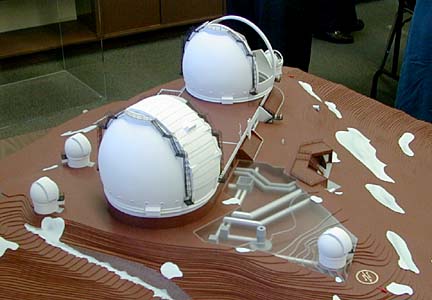


HILO >> Astronomers using the two giant Keck telescopes on Mauna Kea have for the first time linked their light to produce an image of a distant star, the W.M. Keck Observatory announced. Big Isle telescopes
join in finding starThe technology used to link
By Rod Thompson
the telescopes may help find
planets that have life
Big Island correspondentEach of the Keck telescopes has a main mirror 33 feet across.
By linking their light, astronomers produced the effect of a telescope with a mirror 275 feet across, the observatory said.
Combining the light is called interferometry, and when used in that way, the two Keck telescopes are called an interferometer.
"Successfully combining the light from the two largest telescopes on Earth is a fabulous technical advancement for science," said Dr. Anne Kinney, Director of NASA's Astronomical Search for Origins program, which includes Keck.
The image of the star -- 800 light years away in the Lynx constellation, invisible to the naked eye and known only by the number HD61294 -- was done only as a test.
But use of the Keck telescopes as an interferometer will eventually allow searches for planets around nearby stars and will help NASA design future space-based missions that can search for habitable, Earth-like planets.
Keck Interferometer Project manager Paul Swanson said the achievement will eventually lead to a whole new class of telescopes.
It will probably also lead to discoveries that weren't even anticipated when the Keck telescopes were built, he said.
The two telescopes are linked by an underground tunnel. Light from the two instruments was put into a "beam combiner" in the tunnel, the observatory said.
In order to match the beams of light, the system used adaptive optics, which senses distortions in the atmosphere and then removes the distortions from the light.
The optical system had to be adjusted to within a millionth of an inch.
Testing of the interferometry system will continue for several months, to be followed by the beginning of searches for planets in the fall.
Scientists will be invited soon to submit specific proposals for studies.
Using existing technology, which observes the wobble of distant stars caused by large planets circling them, astronomers have detected almost 50 planets about the size of Jupiter, 300 times as massive as Earth.
Like Jupiter, which is not believed to have life on it, the planets discovered outside the solar system are also thought to lack living things.
The interferometry used by Keck is expected to allow astronomers to find smaller, dimmer planets, more like Earth, which might have life on them.
The Keck interferometry program is managed by the California Institute of Technology (Caltech) Jet Propulsion Laboratory for NASA's Office of Space Science.
The Keck Observatory is funded by Caltech, the University of California and NASA, and is managed by the California Association for Research in Astronomy.